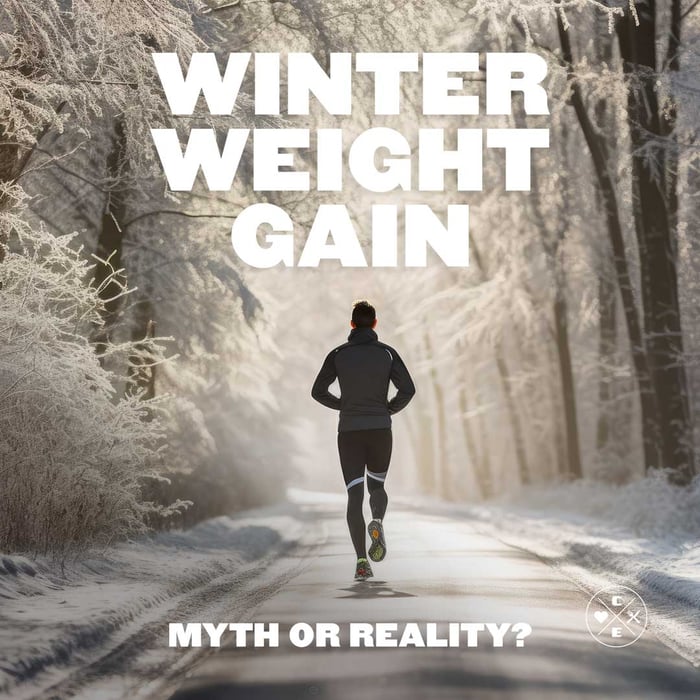Last updated: September 19, 2025
Winter Weight Gain: Myth or Reality?
Short answer: Winter weight gain is partly real. On average, adults gain a small amount around the holiday period (often under 1–2 lb), but because this gain isn’t always lost in spring, it can accumulate over time. The drivers are mostly behavior and environment—food-rich holidays, lower activity, shorter days and mood changes—rather than a “hibernating” metabolism. The good news: with a few smart systems, you can finish winter at—or even below—your fall weight.
What the Evidence Says
- Holiday effect: Studies using repeated weigh-ins show a modest average gain during Nov–Jan that many people don’t fully lose later. Translation: small but sticky. See references.
- Seasonal pattern: Body weight fluctuates week to week and around festive periods; the “automatic winter 10 lb” is a myth for most, but holidays can create creep.
- No true metabolic hibernation: Cold can raise energy expenditure, but most of us live in heated spaces, so behavior dominates.
Why Winter Nudges Weight Up (and What to Do)
- Food environment (parties, desserts, rich drinks). Fix: Prelog your day with a protein-anchored breakfast and lunch; bring/serve a high-volume veg dish and a lean protein.
- Less movement (cold, dark, travel). Fix: Set a daily floor: 8–10k steps or 30 active minutes via indoor circuits.
- Short daylight & mood (SAD for some → carb cravings). Fix: Morning outdoor light or a 10k-lux light box (if appropriate), sleep regularity, protein-with-fiber at meals.
- Alcohol & liquid calories. Fix: “2-drink cap” rule at events; alternate with flavored seltzer; skip sugary mixers.
Two Blueprints to Beat Winter Gain
Option A — “Hold the Line” (maintenance or tiny deficit)
- Calories: maintenance to −200 kcal. Set with our Calorie Calculator.
- Protein: ~0.8–1.0 g/lb/day across 3–5 meals via High-Protein Box, chicken/fish, Greek yogurt, cottage cheese, tofu; add a scoop of Protein Powder when busy.
- Meal structure: Protein + veg volume + smart carb (rice, potatoes, quinoa) + measured fat (1–2 tsp oil).
- Activity: 3–4 lifts/week + 8–12k daily steps or 2–3 × 25–35 min Zone-2 cardio (treadmill, bike, elliptical).
Option B — “Winter Cut” (small, sustainable fat loss)
- Calories: −300 to −500 kcal/day (not aggressive—think consistency).
- Food plan: Standardize 1 breakfast + 1 lunch on repeat, rotate 2–3 simple dinners from Best Healthy Dinner Recipes.
- Convenience lever: Use Build-a-Meal Plan for dinners; keep frozen veg and fruit on hand for volume.
Holiday Plate Strategy (No Calorie Hangover)
- Pre-game: 25–35 g protein + fruit/veg before you go.
- First pass: ½ plate veg/salad, ¼ plate lean protein, ¼ plate starch (potatoes, rice, stuffing).
- Seconds: just protein + veg. Save dessert for last, enjoy mindfully.
- Drinks: seltzer between pours; set a 1–2 drink cap.
- Next day: normal breakfast; long walk; high-protein lunch; hydrate/electrolytes (see Electrolytes guide).
Indoor Activity Menu (10–30 Minutes)
- 10-minute “anywhere”: 3 rounds — bodyweight squats 15, incline push-ups 12, rows (band) 12/side, side plank 20s/side.
- 20-minute step-up: every minute: 40s brisk climb (stairs/step), 20s easy; alternate 5 rounds with light dumbbells.
- 30-minute strength (3×/wk): hinge (RDL), squat, row, press, carry. See 5-Day Workout Routine.
Mindset, Sleep & Light
- Sleep 7–9 h: appetite control and recovery depend on it.
- Morning light: 10–20 min outdoors or a 10k-lux light box within an hour of waking (if suitable for you).
- Track the trend, not the day: weigh 3–4×/wk and watch the weekly average; expect water swings after salty meals.
Helpful CEK Tools, Guides & Meals
- Calculators: Calories • Protein • Weight Loss %
- Guides: Winter-friendly snacks • Smart swaps • Carb basics
- Meals: High-Protein Box • Build-a-Meal Plan • Weight-Loss Meal Plan • Protein Powder
FAQs
How much weight do people actually gain in winter?
Most studies show modest average gains (often under 1–2 lb) clustered around holidays. Small increases matter because they’re not always fully lost afterward.
Does my metabolism slow in winter?
Not meaningfully. There’s no human “hibernation” effect. Real cold exposure can increase calorie burn via brown fat, but indoor heating limits this in daily life.
Is Seasonal Affective Disorder (SAD) linked to winter weight gain?
SAD can raise appetite (especially for carbs) and lower energy. Morning light, steady sleep, activity, and supportive meals can help. Seek clinical support if symptoms are strong.
What’s the single best habit to avoid winter weight gain?
Keep a daily activity floor (steps or minutes) and anchor each meal with 25–40 g protein + veg volume. That combo resists over-eating at events.
Disclaimer: This article is general information, not medical advice. If you have medical or mental health conditions, consult a qualified professional.
References
- Yanovski JA et al. N Engl J Med, 2000 — Prospective holiday weight gain study.
- Helander EE et al. N Engl J Med, 2016 — Holiday weight spikes across countries.
- Turicchi J et al. PLOS One, 2020 — Weekly/seasonal body-weight fluctuation patterns.
- Maher C et al. JAMA Netw Open, 2023 — Seasonal/weekly fluctuations with festive increases.
- Harvard Health — Seasonal affective disorder overview and management.
- van der Lans AAJJ et al. J Clin Invest, 2013 — Cold acclimation recruits brown fat.




